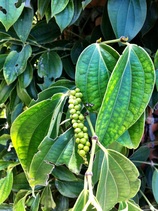
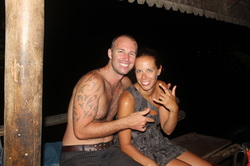
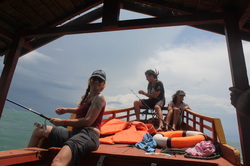
To see all the great pics of this leg, go here: http://flic.kr/s/aHsjzFxH3e
Kampot, in the most Southeastern corner of Cambodia, was one of our favorite towns of our travels thus far. Set on the Kampot River, which is actually an estuary that flows right into the Gulf of Thailand, Kampot has managed to retain its small town charm. The people are incredibly friendly and every evening the locals would line the promenade along the river to watch the spectacular sunsets.  Of course, the part we enjoyed most was all the great food we found here, particularly because it was so locally produced! Kampot is a very unique place as this is where some of the world’s best pepper is grown. Pepper production has been recorded here as early as the 1200s and the region was a major producer until the Khmer Rouge destroyed the pepper plantations in the 70s. Things are now back in full swing and we took full advantage by eating freshly picked green peppercorns with popular seafood like shrimp and crab. Each dish would come with many sprigs of the pepper, which has a delightfully zesty, earthy spiciness when it is fresh. We have never tasted fresh pepper like that before as it usually has to be dried for preservation. We also visited the salt fields, where salt water pools rest peacefully under the sun letting the salt settle to the ground while the water evaporates. It is then collected and stored until it is ready to be bagged and sent to the market. As salt and pepper are staples on tables around the world these days, it got us thinking how eating local crab with local salt and pepper was really embodying the slogan “Go Local”. There is something beautiful about accepting the foods that a region produces at a given time and just eating those foods. We often have found here that when things are out of season people simply do not eat them, whereas in the Western world we spend enormous amounts of energy to import those things that don't grow nearby. That is not to say that it's always bad to import foods as sometimes it is necessary. But being around such simple delicious food that comes from within a few kilometers inspired us to think about eating more locally wherever we go.  Chris and Lauren at Bodhivilla Though the food here was great, the best part about our visit to this town were the new and not so new anymore friends we met there. Our crew we met at the Gibbon Experience in Laos - Cat, Francis, and Claudia - rejoined us at Kampot. At our first dinner in town together, we met Chris and Lauren (see their travel blog here), another Kiwi and a Canadian, who happen to be staying at the same place as us! We ended up partying until 6am that morning at a Riverside bar and guesthouse called Bodhivilla. We danced the night away, swimming in the river in our undies, and seeing the town wake up and sun rise during our hour walk back to our guesthouse.  Dragon Dust, Francis, and Cat The day after the party, we persuaded Chris and Lauren to stick around for our sea fishing trip. Though it was cut slightly short due to a storm, it was fun to boat up the river and out into the sea and do some fishing. For us, it was “physical skill” aspect of Cambodia to learn about fishing in the sea. The “mental skill” was our study of Khmer architecture and history. In the end we caught some fish and grilled them up right on our boat on a little BBQ bucket that you see a lot around SE Asia. Our new friends were heading in the same direction as us, so we four continued to Vietnam together, while we had to say goodbye to our previous posse :(. We will miss them dearly and hope our paths cross again soon!!!! In the meantime, we head to the border town of Ha Tien to begin our exploration of the Mekong River Delta!
To see all the great pics of this leg, go here: http://flic.kr/s/aHsjzFxH3e
1 Comment
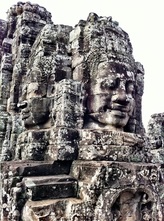 Bayon Temple Next we flew into Siem Reap, a former small town made bustling by the grandeur of the ancient Khmer ruins that lie outside of it. The Angkor complex, consisting of Angkor Wat, Angkor Thom, and many other temple mountains and barays (man-made ponds) is one of the pinnacles of religious architecture in the world. Built between 900-1300 AD, each temple was painstakingly constructed to be either a microcosm of the Hindu universe or a Buddhist shrine (the Khmer empire alternated between Hinduism and Buddhism over its 700 year history). We started our exploration at sunrise, as the light broke over the silhouette of Angkor Wat in a dramatic show of beauty (see pic below). The level of detail present in the temples is staggering – intricately carved asparas (angels) sit alongside bass reliefs depicting great battles and the beginning of the universe. In some temples every square inch of sandstone is covered in intricate decoration. In others, the devarajas (God-king) who constructed the temples had his face prominently displayed in “face-towers” throughout the temple. 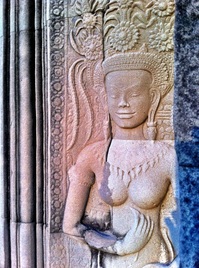 An Aspara (angel) in the sun Neda and I spent two days touring the ruins and using a guidebook to hunt for interesting details of the various temples we visited. Seeing the remarkable attention to detail that the builders put into each building reminded us how important of a tool attention can be. When we really choose to focus our attention, be it on our breath or of the feel of our sits bones on the chair we are sitting on, it brings us back to this present moment and the effect can be transformative. One would think that use of attention in this way might make us tired or worn out, but strangely enough the more you use focused attention, the more of it you receive. Neda has recently commented that after spending an hour or so focusing on her fruit carving, she feels more grounded and focused than before she started. For us, the Khmer art was inspiring as a source of this focused attention and its ability to create beauty that reverberates through time. 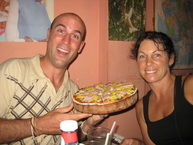 Cat and Jeff with Happy Pizza We enjoyed our time in Siem Reap as well, though perhaps not for focused attention :). Some friends we met during the Gibbon Experience also came to Siem Reap and we hung out together in the evenings, culminating on Friday night (4/20) in our sampling of the famous “Happy Pizza,” whose title did not disappoint! Next, we stopped at the capital of Cambodia, Phonm Phen, to find busy and bustling streets with lots of traffic and honking. We spent our one day there honoring our niece Allie’s memory at Wat Phnom with pink lotuses, rambutan offerings, and meditation at the temple. Today, we traveled even more south and circled back to the Gulf of Thailand from the Cambodia border this time. We will be spending the next week in a small fishing village called Kampot, relaxing and exploring the countryside of Cambodia before heading to Vietnam. See the amazing pics of Angkor (categorized by temple) as well as our time in Siem Reap here: http://flic.kr/s/aHsjzyojvi. See the shots of our time in Phonm Phen (Royal Palace, Riverfront, Wat Phnom) here: http://flic.kr/s/aHsjz39hHm
|